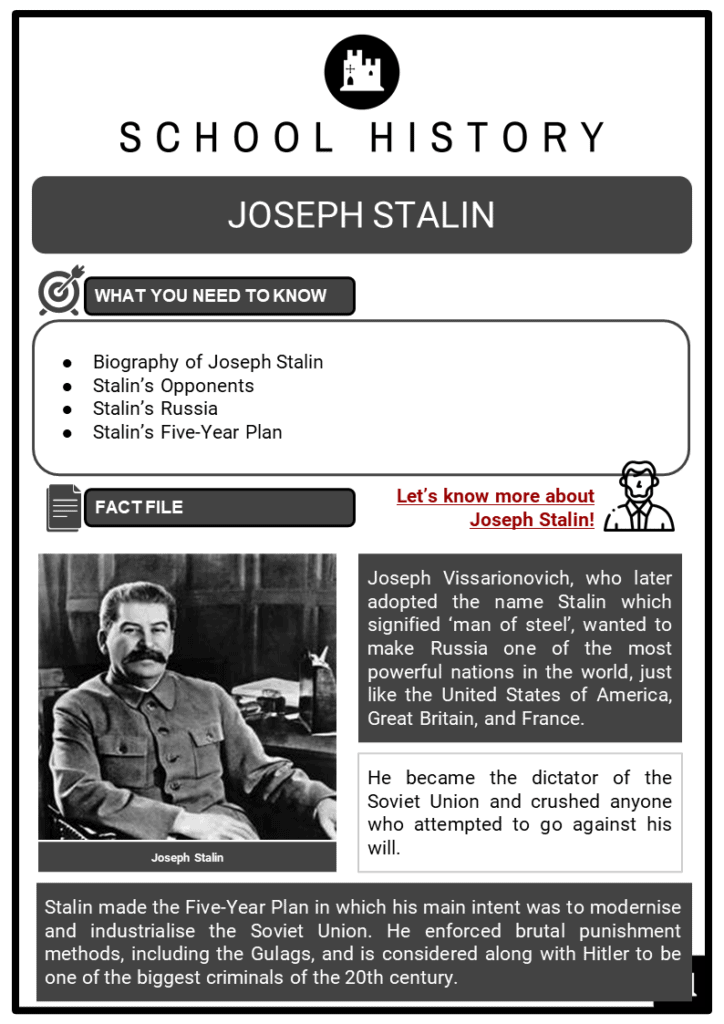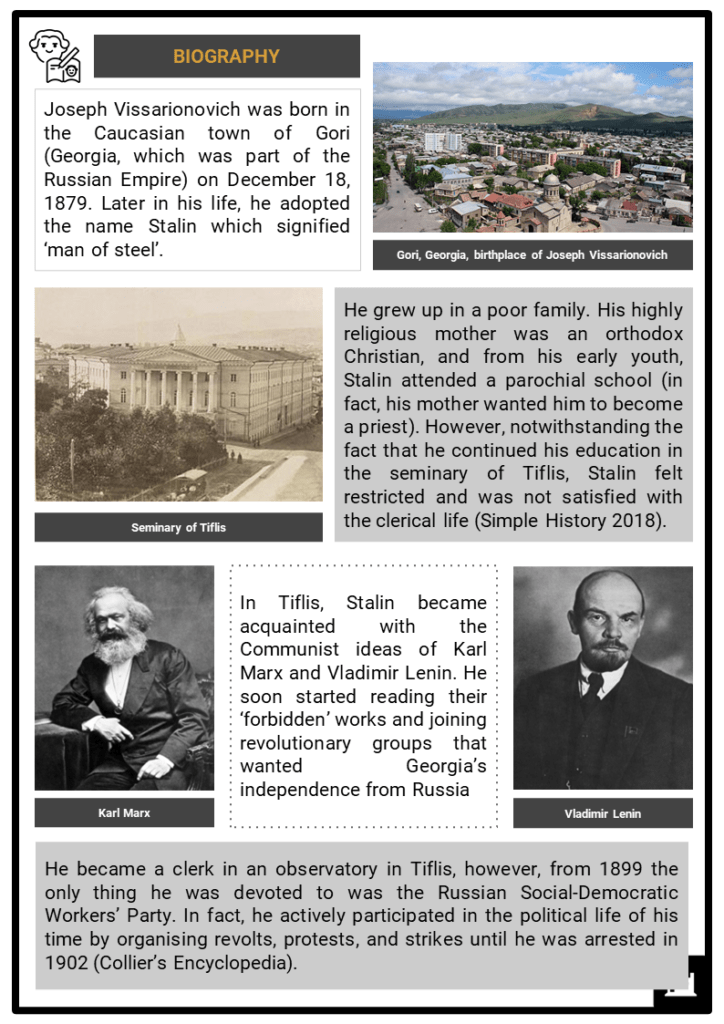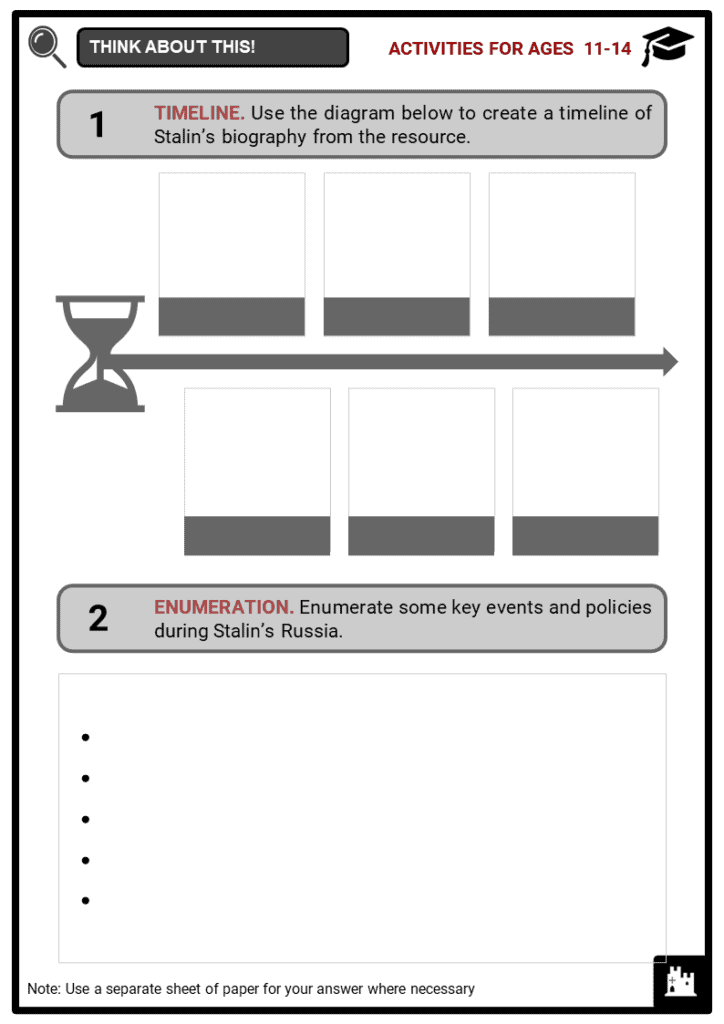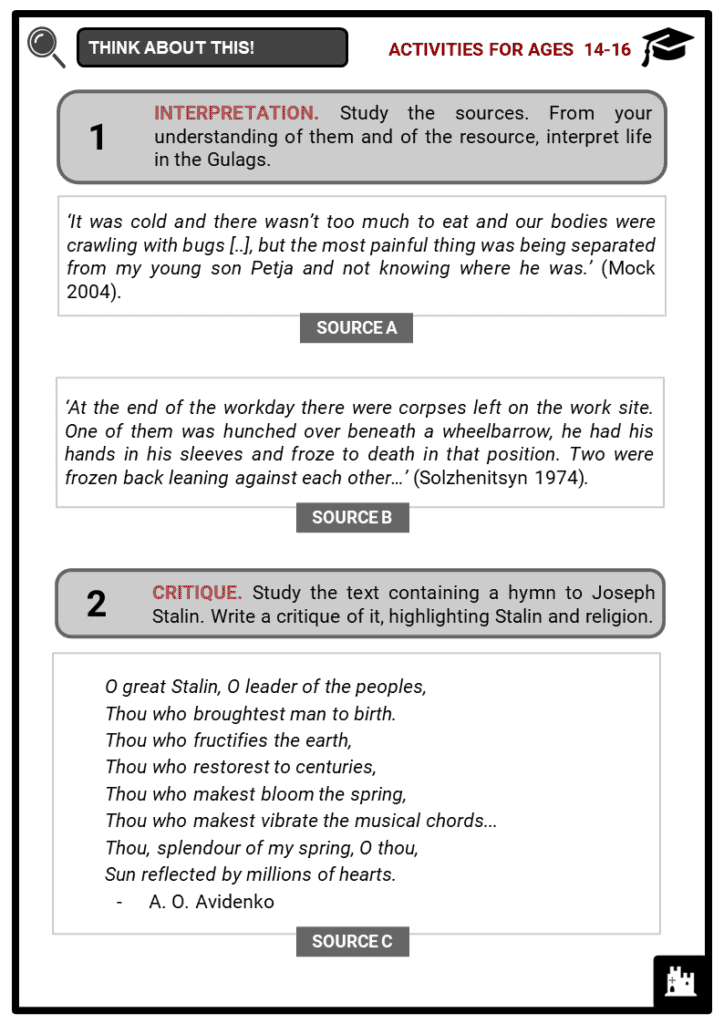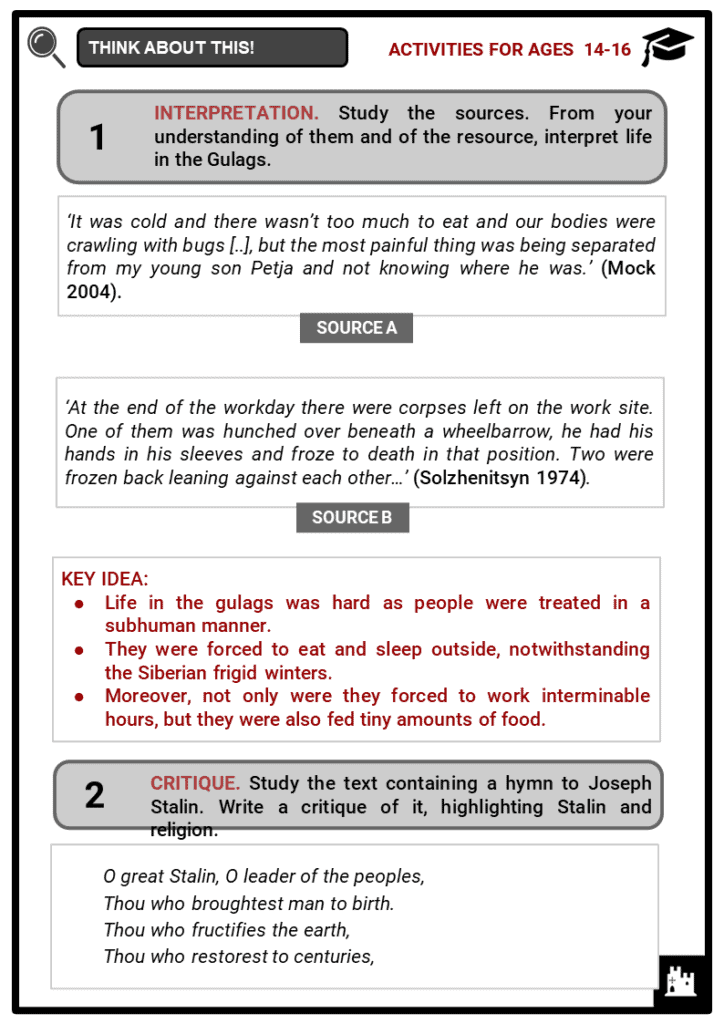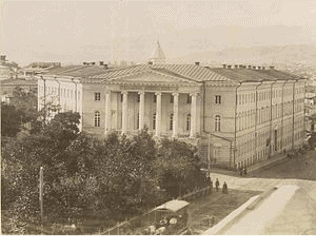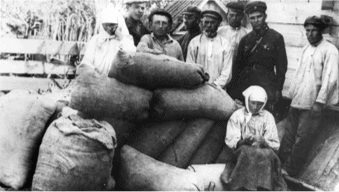Download Joseph Stalin Worksheets
Do you want to save dozens of hours in time? Get your evenings and weekends back? Be able to teach Joseph Stalin to your students?
Our worksheet bundle includes a fact file and printable worksheets and student activities. Perfect for both the classroom and homeschooling!
Table of Contents
Add a header to begin generating the table of contents
Summary
- Biography of Joseph Stalin
- Stalin’s Opponents
- Stalin’s Russia
- Stalin’s Five-Year Plan
Key Facts And Information
Let’s know more about Joseph Stalin!
- Joseph Vissarionovich, who later adopted the name Stalin which signified ‘man of steel’, wanted to make Russia one of the most powerful nations in the world, just like the United States of America, Great Britain, and France.
- He became the dictator of the Soviet Union and crushed anyone who attempted to go against his will.
- Stalin made the Five-Year Plan in which his main intent was to modernise and industrialise the Soviet Union. He enforced brutal punishment methods, including the Gulags, and is considered along with Hitler to be one of the biggest criminals of the 20th century.
Biography
- Joseph Vissarionovich was born in the Caucasian town of Gori (Georgia, which was part of the Russian Empire) on December 18, 1879. Later in his life, he adopted the name Stalin which signified ‘man of steel’.
- He grew up in a poor family. His highly religious mother was an orthodox Christian, and from his early youth, Stalin attended a parochial school (in fact, his mother wanted him to become a priest). However, notwithstanding the fact that he continued his education in the seminary of Tiflis, Stalin felt restricted and was not satisfied with the clerical life (Simple History 2018).
- In Tiflis, Stalin became acquainted with the Communist ideas of Karl Marx and Vladimir Lenin. He soon started reading their ‘forbidden’ works and joining revolutionary groups that wanted Georgia’s independence from Russia.
- He became a clerk in an observatory in Tiflis, however, from 1899 the only thing he was devoted to was the Russian Social-Democratic Workers’ Party. In fact, he actively participated in the political life of his time by organising revolts, protests, and strikes until he was arrested in 1902 (Collier’s Encyclopedia).
- 1903 - After his exile in Siberia in 1903 and the splitting of the party between Mensheviks and Bolsheviks, Stalin joined the latter and escaped Siberia the following year (Collier’s Encyclopaedia).
- In regards to his love life, Stalin was married twice: his first wife, whom he married in 1904 died three years later due to tuberculosis. His second wife (married in 1919) died in 1932 under mysterious circumstances (Collier’s Encyclopaedia).
- 1905 - Lenin met Stalin in Finland in 1905 and was impressed by the zeal with which Stalin organised revolts and raised money for the party by robbing the State Bank (Simple History 2018). Following this action, he was imprisoned for six months in Baku and subsequently exiled in Vologda (Collier’s Encyclopaedia).
- 1917 - Notwithstanding the several arrests and exiles that he had to endure between 1902 – 1917, during the Russian Revolution in October 1917, Stalin took charge of the Bolshevik journal Pravda.
- 1924 - In 1924, Lenin – the leader of the Bolshevik party – died and everyone expected Leon Trotsky to succeed him. However, the tables turned to his disadvantage, and Stalin formed a triumvirate with Grigory Zinoviev and Lev Kamenev. He successfully managed to exile Trotsky.
- Moreover, it was certain that Lenin did not want Stalin to be the leader of the Bolsheviks since, as he wrote in his own will, he believed that ‘Stalin must be removed [as] he is too rude and this fault, supportable in relations among us Communists, becomes insupportable in the office of the Secretary-General’ (Collier’s Encyclopaedia).
- As the new leader of the Soviet Union, Stalin wanted to be photographed and depicted as a national hero without any flaws. Similar to Hitler, he wanted to be represented as a ‘father figure devoted to his people’ (Duley 2016).
- As a child, Stalin had suffered from smallpox, which had left scars on his face. In order to keep his image of ‘perfection’, all his photos were retouched with the purpose of hiding any marks of the sickness he had when he was younger (Duley 2016).
- Despite Lenin’s intention, Stalin was now the leader of the Soviet Union, and he had firm plans for his nation. Throughout his dictatorship, he would not stand any resistance to his command and would wipe out any opponents.
- In 1939, Stalin signed the Molotov-Ribbentrop Pact with Germany, which assured a state of neutrality and non-belligerence. Although the USSR was shocked by the agreement, Stalin justified the act by stating the necessity to keep out of the conflict and ‘calming the troubled waters of Europe’ (Collier’s Encyclopaedia).
- However, Stalin’s ambitions became clear when the USSR occupied a part of Poland following its defeat during the German blitzkrieg.
- Stalin’s dictatorship lasted for twenty-nine years, and ended only because of his death in the Kremlin on March 5, 1953, due to a brain haemorrhage.
Stalin’s Opponents
Gulags
- In the gulags, people were treated in a subhuman manner.
- They were forced to eat and sleep outside, notwithstanding the Siberian frigid winters.
- Moreover, not only were they forced to work interminable hours, but they were also fed tiny amounts of food.
- It is not surprising to discover that in one year, the death rate in the gulags reached 20%.
- One gulag survivor recalls... ‘It was cold and there wasn’t too much to eat and our bodies were crawling with bugs [..], but the most painful thing was being separated from my young son Petja and not knowing where he was.’ (Mock 2004).
- Another survivor remembers: ‘At the end of the workday there were corpses left on the work site. One of them was hunched over beneath a wheelbarrow, he had his hands in his sleeves and froze to death in that position. Two were frozen back leaning against each other…’ (Solzhenitsyn 1974).
The Great Purges
- By 1934, Stalin was eliminating all his opponents. This is also known as the great period of terror in which ‘Bolsheviks, party bosses, military leaders, industrial managers, and high government officials’ were wiped out of the equation (Hingley no date).
- In fact, around 40,000 people were killed in Leningrad, whereas ‘in a forest near Toksovo, a mass grave containing the bodies of 32,000 people was discovered’ (Hays 2008).
Stalin’s Russia
- Education in Russia was controlled by the state.
- In 1932, a very strict programme of discipline was introduced. Previously banned exams were reintroduced and the government dictated how subjects were taught.
- For instance, in History, Stalin’s relationship with Vladimir Lenin in the 1917 March Revolution was exaggerated.
- Students were left in the dark on some issues as the government censored most things. Furthermore, a new book called A Short History of the USSR was introduced, to be used in schools.
- There were a number of attacks on churches in the USSR throughout the 1930s.
- Communism viewed religion, and Christianity in particular, as a threat. As a result, church leaders were arrested and places of worship destroyed.
- Stalin felt that the Church challenged his authority and he viewed anyone who worshipped God as an enemy. Because of his egomania, Stalin wanted people to worship him instead.
- Communists had the goal of replacing religion with the “great” ideas of communism.
- Women under Vladimir Lenin enjoyed some freedom compared to the days under the Romanov dynasty.
- Divorce could be conducted easily under Lenin, but Stalin changed all this as he emphasised the importance of family.
- This was because many children had been born to parents who were not yet married and by 1930, Moscow was full of homeless children who portrayed a negative picture of the so-called “perfect communist society” that Stalin was trying to build.
- Married couples were then offered a child allowance. Moreover, restrictions were placed on divorces and abortions and as a result, ceremonial weddings made a comeback.
- A command economy was put in place in 1928 where the government made all economic decisions.
- Stalin came up with a five-year plan for the development of the Soviet Union’s economy. The government seized over 25 million farms that were privately owned in the USSR. They were combined into a collective farm owned by the government. People became better educated and were empowered with new technical skills.
The Five-Year Plan
- Stalin wanted to transform the USSR into an industrialised and collectivised society with the intention of strengthening the country’s economy.
- For this reason, when he implemented the Five Year Plans between 1928 – 1941, Stalin’s objective was that of rendering Russia one of the most potent nations in the world, along with the United States, Great Britain, and France (Swift 2015).
- In fact, Stalin himself claimed: ‘We are fifty or a hundred years behind the advanced countries. We must make good this lag in ten years. Either we do it or they crush us.’ Compared to the other powers in Europe, Russia was decades behind and still lived in a peasant state.
First Plan (1928-1932)
- During the First Plan, major importance was placed on the development and modernisation of heavy industry.
- The industry’s development was one of Stalin’s obsessions which could be carried out only with a substantial workforce and expensive machinery. Stalin introduced collectivisation by seizing the farmers’ lands, in order to drive people towards the cities.
- The dictator wanted to create ‘large state-run farms’ and introduced quotas that had to be necessarily reached within a set time (Sargent 2016). The people who worked on the farm (and that previously owned the land), were not allowed to eat any of the food that was produced before they had reached the quota that the government had imposed (Sargent 2016).
- In essence, the farmers could not eat unless they overproduced. Stalin had established this rule since he had to ensure food to the factory workers in the city which in their turn would ensure the production of steel, coal, and iron (Sargent 2016).
- Although food reached the cities, the rural areas of the USSR greatly suffered. In fact, between seven and eight million people died because of starvation and the harsh working conditions they had to endure on a daily basis. In essence, farmers survived on ‘grass, bark, and an occasional rabbit.’ (Hays 2008).
- Naturally, Stalin encountered resistance, and kulaks (i.e. rich peasants) carried out acts of rebellion against the dictator’s regime by burning their grain and killing their animals in order to avoid handing them over to the government. Stalin dealt with the kulaks by murdering them, or by sending them to the Gulags, or to Siberia. The state would ensure that farmers would not steal the food destined for the government.
Second Plan (1933-1937)
- The Second Plan was about demonstrating to the rest of the world that whilst Europe was struggling with the Great Depression and the fall of Capitalism, everyone in the USSR had a job and was assured a living. This plan was focused on consumer goods.
- However, Germany’s war ambitions kept the USSR producing armaments and other weapons. For this reason, the quality of consumer goods was extremely low.
Third Plan (1938-1941)
- The Third Plan’s objective was that of ensuring the correct functioning of the railway system and other transportation.
- In 1941, Hitler broke the Molotov-Ribbentrop Pact with Stalin and attacked the USSR. This put more strain on workers for the production of weapons, tanks, and other military technology.
Fourth Plan and Fifth Plan (1945-1950; 1951-1955)
- Following Hitler’s attack and the destruction caused by the war, once again Russia had witnessed a tremendous loss. Stalin’s fourth and fifth plans consisted of reconstructing the country, and he promised his people that by 1960 the USSR would become ‘the leading industrial power.’ (HBA 2010).
- However, the process of reconstruction was slowed down not only by ‘a chronic labour shortage due to the enormous number of Soviet casualties in the war’, but also by 1946’s ‘poor harvest’ (HBA 2010).
Image sources:

